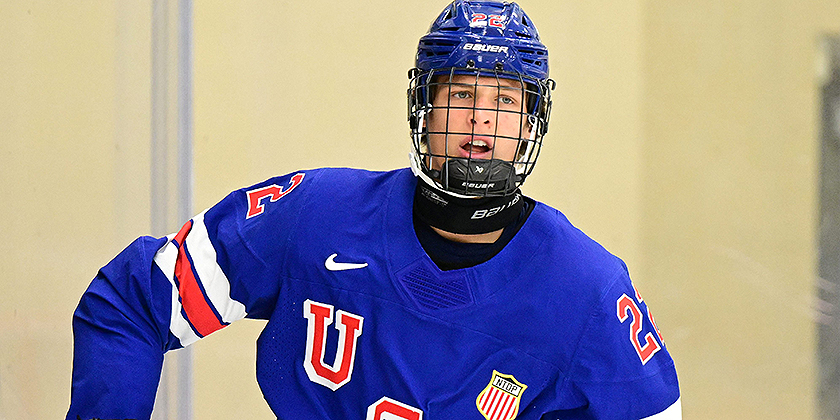
William Horcoff (LW, L, 6’5″, 190, Michigan, 01/23/2007, Michigan)
William Horcoff is a long limbed forward with NHL bloodlines, power-forward attributes, and pro habits already forming in his off-puck game. While still raw and physically underdeveloped for his frame, Horcoff has made a relatively smooth transition to the NCAA level after a mid-season move from the NTDP, earning a middle-six role at even strength and power play usage. He’s an intelligent player with offensive zone instincts, a net-front presence, and the ability to create off the cycle. However, his game currently lacks burst, strength, and puck control consistency. Horcoff is a long-term project with a potentially high ceiling. His combination of size, feel, and NHL translatability makes him a worthy consideration in the middle rounds of the 2025 Draft.
Case For Drafting William Horcoff:
- NHL Frame and Foundation Tools
At 6’5″, Horcoff has the frame and natural reach that NHL teams covet. Despite being just 190 lbs, he consistently extends offensive plays down low and shields off defenders well when engaged. He gives 1.0 hard hits/game and does so with intent, despite not being a true power forward yet. - High-End Offensive Zone Intelligence
Horcoff averages 2 Grade “A” scoring chances/game—an elite figure—due to his feel for timing, body positioning, and working into the slot off the puck. His 1.68 loose puck recoveries after shots/game is also high-end and reflects his anticipation and game sense around the crease. - Steady Puck Movement and Passing Awareness
He completes 84% of his passes, showing he isn’t careless with the puck. His 0.59 completed passes/game leading to a teammate’s Grade “A” chance shows his ability to make smart decisions in the offensive zone—whether below the goal line, off the half wall, or with a quick touch around the net. - Positional Versatility & System Buy-In
Despite growing up as a center, Horcoff has shown the ability to play both wing and down the middle. He’s been trusted with 2:45 of PP time/game in a high-end NCAA program and doesn’t cheat in the defensive zone. Coaches trust him to execute systems and support the puck with purpose. - NHL Bloodlines and Hockey IQ
Son of longtime NHLer Shawn Horcoff, William shows a mature approach to the game, especially off the puck. His anticipation, positional awareness, and patience with the puck point to high-level hockey sense. He’s not reckless—and that maturity shows in his play recognition and composure.
Case Against Drafting William Horcoff:
- Lacks Physical Strength & Battle Readiness
Despite his frame, Horcoff wins just 37% of 50/50 puck battles/game—a clear indicator that he is still developing functional strength and power at this stage. He’s not yet hard to play against in contested areas and needs a multi-year weight room commitment. - Inefficient Shooting Execution
Though he gets 3.5 shot attempts/game, only 2.3 reach the net, with 0.53 blocked and 0.65 missing the net. His 9% conversion on Grade “A” chances is below average and reflects a need to improve deception, release variety, and ability to finish in tight. - No Penalty Kill or Defensive Impact Yet
Despite his frame and intelligence, Horcoff has not been used on the penalty kill. He’s not a liability, but he’s yet to develop the lateral quickness or assertiveness to be a matchup or shutdown option. For a player of his profile, that’s something evaluators want to see emerge. - Below-Average Footspeed and Explosiveness
Described as “still growing into his feet” in Neutral Zone’s prior scouting reports, Horcoff’s open-ice speed remains below average. He doesn’t separate in transition, and when forced wide or into speed races, he can struggle to keep pace with more dynamic skaters. - Giveaway Rate and Puck Control Inconsistency
His 4.6 giveaways/game reflect both physical underdevelopment and a tendency to rush decisions when pressured. He does not yet consistently protect the puck against faster or more aggressive defenders and often gets stripped cleanly below the dots.
Projection & Recommendation:
NHL Projection: Middle-six NHL forward with power play net-front value and two-way upside.
Draft Range: End of 2nd–early 3rd round.
Comparable: Lawson Crouse
Development 4+ years (needs time to fill out, refine stride, develop board and crease game)
Final Recommendation:
Target William Horcoff as a long-term project with NHL tools and processing. He offers a rare blend of size, hockey IQ, and crease-level anticipation, and the foundation of a modern power winger is already forming. However, he must gain considerable strength, improve puck control under pressure, and continue refining his skating to project into a bottom-six NHL role. As he physically matures, adding both strength and pace to his game, Horcoff has the potential to be an effective support winger or net-front contributor with middle-six upside. He’s not ready-made, but the foundation is strong enough to bet on.
Photo credit: Dan Hickling/Hickling Images
